Click on images to enlarge
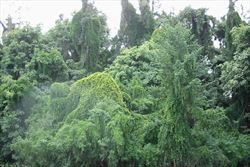
infestation (Photo: Sheldon Navie)
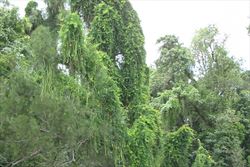
habit (Photo: Sheldon Navie)

habit in flower (Photo: Sheldon Navie)

older woody stems (Photo: Sheldon Navie)

close-up of older stem showing rootlets (Photo: Sheldon Navie)
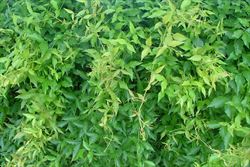
younger stems and leaves (Photo: Sheldon Navie)

flowers (Photo: Sheldon Navie)
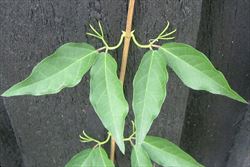
leaves with clawed tendrils (Photo: Sheldon Navie)
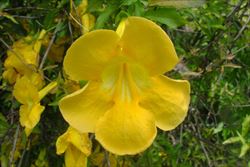
close-up of flower (Photo: Sheldon Navie)
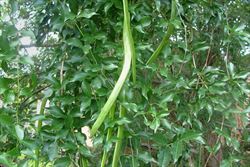
immature fruit (Photo: Sheldon Navie)

mature fruit (Photo: Sheldon Navie)

close-up of mature fruit (Photo: Sheldon Navie)
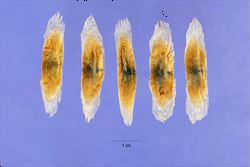
close-up of seeds (Photo: Steve Hurst at USDA PLANTS Database)
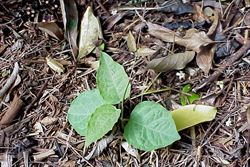
seedling with simple leaves (Photo: Sheldon Navie)
Scientific Name
Dolichandra unguis-cati (L.) L.G.Lohmann
Synonyms
Macfadyena unguis-cati (L.) A.H.Gentry
Bignonia acutistipula Schltdl.
Bignonia inflata Griseb.
Bignonia tweediana
Lindl.
Bignonia unguis L. ex DC.
Bignonia unguis-cati L.
Doxantha unguis-cati (L.) Miers
Family
Bignoniaceae
Common Names
cat's claw, cat's claw climber, cat’s claw creeper, cat's claw vine, catclaw creeper, catclaw trumpet, catclawvine, cat's-claw creeper, claw vine, funnel creeper, macfadyena, yellow trumpet vine
Origin
Native to Mexico, Central America (i.e. Belize, Costa Rica, Guatemala, Honduras, Nicaragua and Panama), the Caribbean and tropical South America (i.e. French Guiana, Guyana, Surinam, Venezuela, Brazil, Bolivia, Colombia, Ecuador, Peru, Paraguay and northern Argentina).
Cultivation
Cat's claw creeper (Dolichandra unguis-cati) has been widely cultivated as a garden ornamental. Nowdays it is usually not deliberately cultivated, and is mainly regarded as a weed when growing in gardens.
Naturalised Distribution
This widely distributed species is mostly found in the coastal and sub-coastal areas of south-eastern Queensland and north-eastern New South Wales. It is also present in central and northern Queensland, on the New South Wales central coast, and sparingly naturalised in Victoria.
Also naturalised in southern Africa (e.g. South Africa and Zimbabwe), tropical Asia, south-eastern USA (i.e. Florida, Georgia, Texas, Louisiana and South Carolina), the Mascarenes (i.e. La Réunion) and on several Pacific islands (i.e. Hawaii, New Caledonia, Niue and Vanuatu).
Habitat
A weed of tropical, sub-tropical and warmer temperate regions. This species was introduced as a garden plant (i.e. ornamental) and is still often found growing in gardens. It is most commonly naturalised along waterways and in disturbed rainforests, where it often smothers tall trees. Also found in open woodlands, plantations, waste areas, disturbed sites, along roadsides, and growing over fences and old buildings.
Habit
A long-lived (i.e. perennial) woody climber (i.e. liana) or creeper that is very rampant and can reach up to 30 m in height. It also develops an extensive, tuberous root system.
Distinguishing Features
- a rampant climber with stems that eventually become very robust and woody in nature.
- its oppositely arranged leaves consist of two leaflets and a distinctive three-clawed tendril.
- its very showy yellow flowers are tubular (4-8 cm long) with five petal lobes.
- its mature fruit are dark brown and strap-like in appearance (15-50 cm long and 8-12 mm wide).
- these fruit contain numerous papery, winged seeds.
Stems and Leaves
Younger stems are hairless (i.e. glabrous) and green in colour, often with reddish-brown or bronze coloured tips. The stems turn light brown or greyish and become woody as they age (old stems can be up to 15 cm or more thick). Older stems adhere to supports via short rootlets, while younger stems adhere to supports via the claw-like leaf tendrils.
The compound leaves are oppositely arranged and are borne on leaf stalks (i.e. petioles) 5-25 mm long. They consist of a pair of oval (i.e. elliptic) to slightly elongated (i.e. lanceolate) leaflets and a third 'leaflet' that has been modified into a small three-clawed tendril (each claw is 3-17 mm long). The leaflets (10-80 mm long and 4-30 mm wide) are hairless (i.e. glabrous) with entire margins and pointed tips (i.e. acute or acuminate apices). However, young seedlings have simple leaves with slightly toothed margins.
Flowers and Fruit
The showy bright yellow flowers (4-10 cm long and up to 10 cm wide) are tubular and have five petal lobes (i.e. corolla lobes), each about 1-2 cm long. These flowers usually have several fine reddish-orange lines in their throats. They also have five partially fused sepals (i.e. a calyx tube) 10-18 mm long. Flowers are borne singly or in small clusters originating in the leaf forks (i.e. in axillary clusters) and flowering occurs mainly during late spring and early summer.
The fruit (15-50 cm long and 8-12 mm wide) are initially glossy green in appearance, but turn dark-brown as they mature. They are very elongated (i.e. linear), flattened, strap-like capsules (i.e. they are not pods). Each fruit contains numerous papery seeds (10-40 mm long and 4-10 mm wide). These oblong seeds have two see-through (i.e. translucent) wings that are not easily separated from the rest of the seed.
Reproduction and Dispersal
This plant reproduces by seed, as well as vegetatively via its tuberous root system.
Seeds are usually dispersed by wind and water, while the tuberous roots may be spread by floods and during human activities involving significant soil movement.
Environmental Impact
Cat's claw creeper (Dolichandra unguis-cati) is particularly aggressive in riparian vegetation in south-eastern Queensland and north-eastern New South Wales, but is also a potential threat to riparian and rainforest plant communities throughout the sub-tropical and tropical zones of eastern and northern Australia. It was recently ranked as the fourth most invasive alien plant species in south-eastern Queensland, and is currently regarded as a priority environmental weed in five Natural Resource Management regions.
Cat's claw creeper (Dolichandra unguis-cati) has the ability to completely smother native vegetation, even growing up over tall trees, and many bushland areas in eastern Australia have serious infestations of this species. It can grow as a ground cover along the forest floor of scrub remnants and can form a thick carpet of stems and leaves which chokes out small existing plants and prevents the germination of all other species. The large climbing stems can also reach to the top of the rainforest canopy where, through a combination of weight and shading, they can cause the eventual death of the largest canopy trees. The vigorous and extensive root system, which produces large tubers at about 50 cm intervals, also adds to the invasiveness of this weed.
Legislation
This species is declared under legislation in the following states and territories:
- Queensland: Class 3 - this species is primarily an environmental weed and a pest control notice may be issued for land that is, or is adjacent to, an environmentally significant area (throughout the entire state). It is also illegal to sell a declared plant or its seed in this state.
- New South Wales: Class 4 - a locally controlled weed. The growth and spread of this species must be controlled according to the measures specified in a management plan published by the local control authority and the plant may not be sold, propagated or knowingly distributed (in the Bellingen, Hornsby, Hunters Hill, Ku-ring-gai, Lane Cove, Manly, Mosman, North Sydney, Parramatta, Ryde, Warringah and Willoughby local authority areas only).
- Western Australia: Prohibited - on the prohibited species list and not permitted entry into the state.
Management
For information on the management of this species see the following resources:
- the Biosecurity Queensland Fact Sheet on this species, which is available online at http://daff.qld.gov.au.
Similar Species
The claw-like tendrils on its leaves make this species quite distinctive, hence it is rarely confused with other species.
Some populations of slightly different plants have recently been sighted in south-eastern Queensland, with larger leaflets and hairy stems. These plants are currently believed to be a form of cat's claw creeper (Dolichandra unguis-cati), however they are sometimes given the common name "bat's claw creeper".

